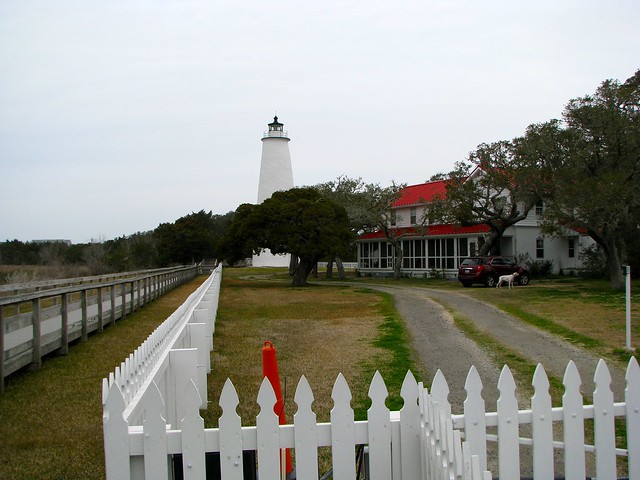Ocracoke Island, North Carolina (March 2012)

The primary reason we went through the trouble of riding the ferry to Ocracoke Island from Hatteras was to see the old lighthouse (map). Construction of this version occurred in 1823 although lighthouses watched over Ocracoke Inlet since 1795. The need had long been established. English explorers first wrecked a ship here in 1585. However, it took awhile before officials got around to building one.
Dangerous Passage
Previously, Ocracoke served as a hideout for Edward Teach, the nefarious Blackbeard the Pirate. He finally met his demise here in the early Eighteenth Century. These waters presented dangers in more ways than one although law-and-order gradually took hold. Protected ports on the inland side of the sound such as Elizabeth City and New Bern grew into refuges. Still, only one easy path led past the Outer Banks and into the sound: the dangerous slot between Ocracoke and Portsmouth Islands. Mariners desperately needed a lighthouse to guide them through difficult waters.
An initial attempt failed: a wooden tower eventually migrating a mile away from where it needed to be as the channel shifted over the next couple of decades. The current one however, built at the beginning of the Nineteenth Century, succeeded. The Ocracoke Light was a target during the Civil War just as were the other Outer Banks lighthouses. It didn’t suffer as badly as some of the others, though. Confederate forces dismantled the Fresnel lens but Union forces later reinstalled it. The remainder of its life has been rather more sedate, performing its duties now coming up on two centuries.
The Light

Ocracoke Island Light stands at a somewhat diminutive 65 feet with a focal plane of 75 feet (built onto a small rise of land that proved to be quite an advantage during hurricanes that occasionally sweep the Outer Banks). Its design features a masonry structure layered with mortar and painted white. The optic is a 4th Order Fresnel Lens, automated in 1955.
A 2-story Lighthouse Keepers quarters graces the same property, used as housing for National Park Service employees. Nearly the entirety of Ocracoke Island is part of the Cape Hatteras National Seashore, including a visitors center on the Island. Thus, there are plenty of park rangers on Ocracoke at any given time and they have to live somewhere. However, since the light continues to serve as an active aid to navigation and the quarters serve as a residence for park rangers, the facilities do not open to tourists. Visitors can take a wooden boardwalk that runs from a small parking area to the base of the lighthouse, but that’s as close as anyone can get.
Beyond the Light
Still, there are plenty of other things to do on Ocracoke Island, from exploring the town through enjoying the unspoiled natural beauty of the dunes. So after traveling across from Hatteras on the ferry, driving down the length of Ocracoke and spending a few minutes at the lighthouse, it’s still a great journey with more of the island left to discover.
Readers who have an interest in lighthouses might also want to check my Lighthouse Index page.

Leave a Reply